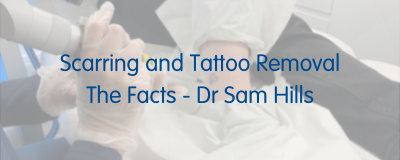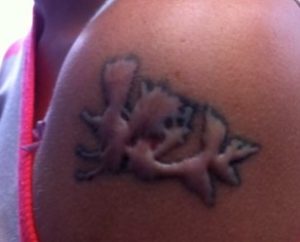
Scarring and Tattoo Removal – The Facts
Dr Sam Hills, Clinical Director, Lynton Lasers Ltd
It always amazes me that when I talk about laser tattoo removal to my friends, the first question they always ask me is ‘What sort of scar does it leave?’ as if this is something you need to put up with if you’re having a tattoo removed. The beauty of Q-Switch laser tattoo removal, is that the risk of scarring is incredibly low if you’re using medical-grade equipment and are being treated by someone who has had proper training. Lynton were one of the first companies in the world to manufacture a Q-Switch laser for tattoo removal, and we’ve been selling these systems for over 20 years now, so I think it’s safe to say we know our stuff when it comes to tattoo removal.
Using a Q-Switch laser breaks down the tattoo into particles much smaller than the original clumps of pigment, which means that the white blood cells in your body can remove it naturally (in the same way that they remove bacteria or other foreign bodies in the skin, via the wonderfully-named process of phagocytosis). This means that scarring is thankfully very rare following laser tattoo removal. That’s not to say that side-effects are unheard of. The lack of regulation in the UK at the moment means there are people out there who are using very cheap, imported equipment, without any appropriate training and these providers are a real problem in the industry. But even when using high-spec equipment, it’s not guaranteed that you won’t encounter side effects. You may see pigment changes in the skin for example (especially if you have darker skin) but these are not usually permanent. Very occasionally (especially when treating red tattoos) you may see some blistering following treatment, but these blisters are very superficial and unless they get infected, they shouldn’t cause any long-term effects in the skin (after all, you’d be really unlucky to be left with a scar after a blister caused by wearing ill-fitting shoes, otherwise my feet would be covered with them!)
However, there are some methods of tattoo removal that have a much higher risk of causing damage. Any method of tattoo removal where the pigment is removed through the epidermis (the topmost layer of skin) has a much higher incidence of scarring. These methods include dermabasion, salabrasion (removing the tattoo with rock salt!), and even some types of laser (such as ablative C02 lasers). On a regular basis I get photos from Lynton customers showing me incidences of scarring caused by ‘chemical extraction.’ With this method, you re-tattoo the skin with secret ingredients (usually some sort of acid) which then causes a scab to form which helps to draw out the pigment. This probably works ok for very small tattoos, but for larger ones, it can be disastrous. Look at the damage caused by chemical extraction in the photo below. The girl chose this method because she was told ‘it won’t cause scarring like a laser.’ Please, if you’re thinking of having a tattoo removed ask yourself the question, ‘do I want to pay slightly less and let someone inject my skin with mysterious substances that are designed to causing scabbing and irritation, or do I want to use a Q-Switch laser, a tried and tested method that is used in hospitals throughout the world and has underwent numerous clinical studies and has been the subject of dozens of medical papers.’
Looking at the photos I receive on a monthly basis from people who choose the former method leaves me in no doubt about which I would choose.

Keloid scarring caused by attempting to remove a tattoo via ‘chemical extraction’
